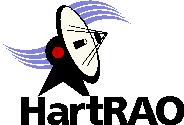One month was available to prepare for the workshop, following the
meeting on 2002 June 10 of groups awarded funds for eclipse projects by
FEST. This took up most of the Science Awareness team's time, with
considerable support from the mechanical workshop staff (Andre van der Merwe
and Attie van Wyk) in manufacturing resources, plus our buyer (Piet Louw) in
locating components.
Special thanks go to Beryl Coetzee, Rebecca Motsweri and Joki Motsweri
for organising the accomodation on site at HartRAO, and providing the
breakfasts, teas and lunches.
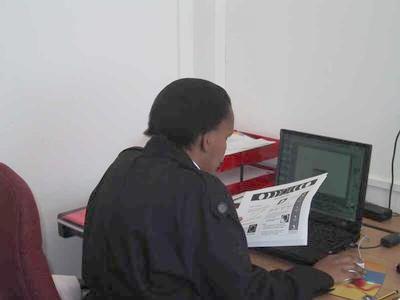 Pulane Moroeng proof reads the A4 leaflet about the eclipse that she is
developing on the computer.
Pulane Moroeng proof reads the A4 leaflet about the eclipse that she is
developing on the computer.
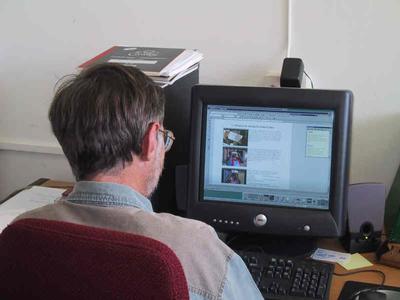 Mike Gaylard writes the notes for the eclipse slide sets that he has made.
Mike Gaylard writes the notes for the eclipse slide sets that he has made.
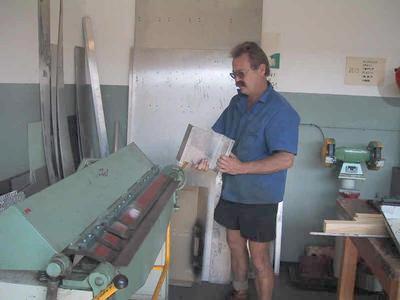 Andre van der Merwe uses the bending brake to make the aluminium body of an
orrery - a mechanical model of the Sun, Earth and Moon.
Andre van der Merwe uses the bending brake to make the aluminium body of an
orrery - a mechanical model of the Sun, Earth and Moon.
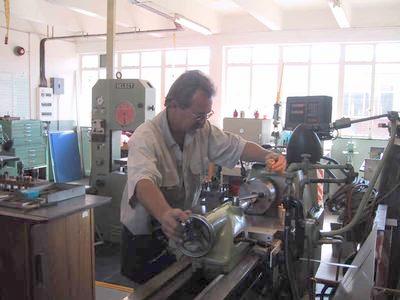 Andre van der Merwe cuts the wooden "cotton reels" for the orreries on the
lathe in the HartRAO mechanical workshop.
Andre van der Merwe cuts the wooden "cotton reels" for the orreries on the
lathe in the HartRAO mechanical workshop.
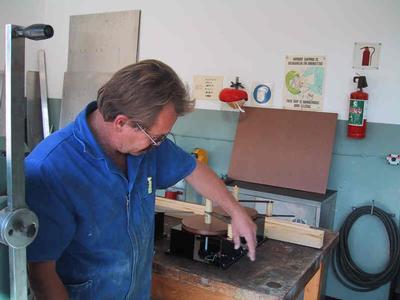 Andre van der Merwe tests the orreries he has built.
Andre van der Merwe tests the orreries he has built.
What size drive bands
are best, he wonders.
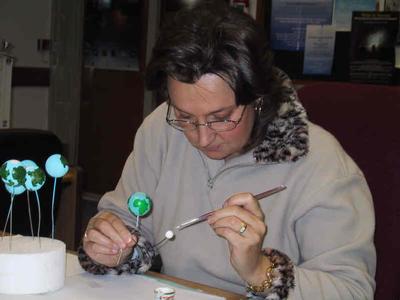 Glenda Coetzer takes time out from the library to paint the Moon and Earth
balls for the orreries.
Glenda Coetzer takes time out from the library to paint the Moon and Earth
balls for the orreries.
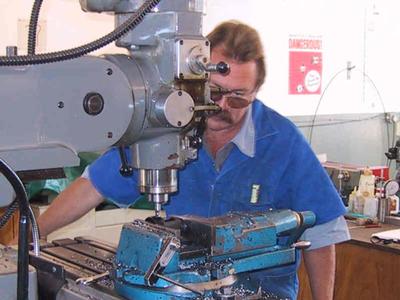 Andre van der Merwe uses the milling machine to cut chunks out of
binoculars so that we can see the optical components inside.
Andre van der Merwe uses the milling machine to cut chunks out of
binoculars so that we can see the optical components inside.
Surprisingly,
they continue to work after this treatment.
The Eclipse Workshop
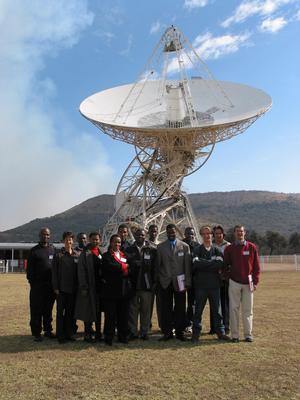 Participants for the workshop gather in front of the radio telescope at
HartRAO.
Participants for the workshop gather in front of the radio telescope at
HartRAO.
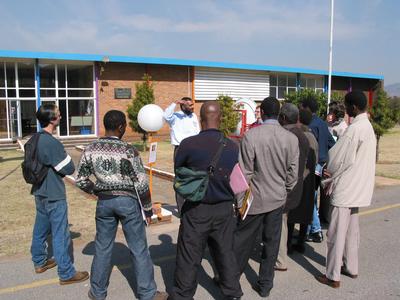 Setting up the scale model of the solar system, Logan Moodley tells us about
the Sun.
Setting up the scale model of the solar system, Logan Moodley tells us about
the Sun.
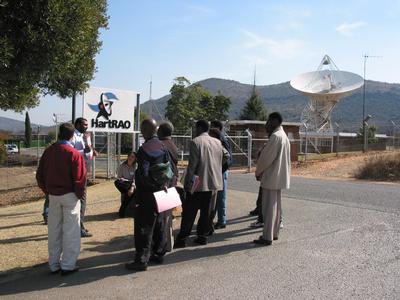 Now seventy eight steps from the Sun in our scale model, we have
reached Mars - the "Red Planet".
Now seventy eight steps from the Sun in our scale model, we have
reached Mars - the "Red Planet".
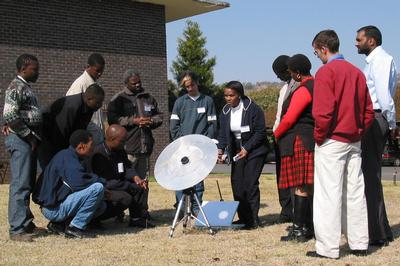 Pulane Moroeng uses the spotting scope to project an image of the
Sun.
Pulane Moroeng uses the spotting scope to project an image of the
Sun.
Three sunspot groups are visible - each spot is bigger than the Earth!
 Pulane Moroeng shows us how to use the eclipse viewers made in
Sutherland to see the Sun safely.
Pulane Moroeng shows us how to use the eclipse viewers made in
Sutherland to see the Sun safely.
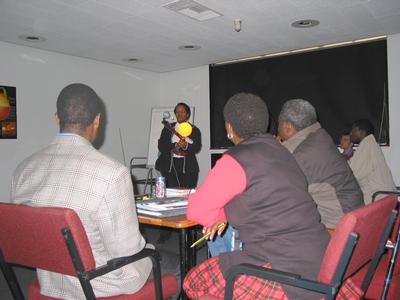 The solar system tilts perilously as Pulane investigates:
The solar system tilts perilously as Pulane investigates:
What causes day and night?
Which way does the Earth turn?
Why do we have seasons?
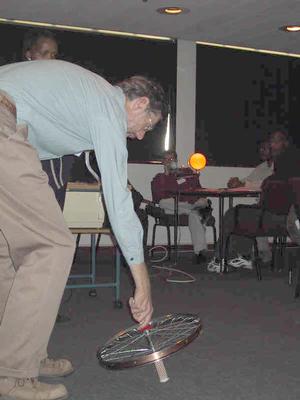 Does the Earth's axis always point in the same direction?
Does the Earth's axis always point in the same direction?
Mike Gaylard uses a spinning weighted bicycle wheel to find out.
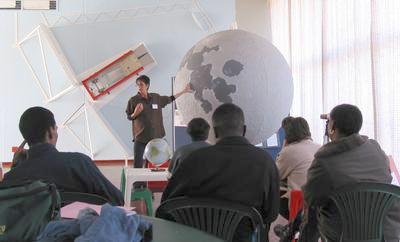 Kim de Boer tells us about the Moon using the globe in the Visitors
Centre.
Kim de Boer tells us about the Moon using the globe in the Visitors
Centre.
She is touching the "rabbit" on the Moon - which is upside down on
the model as it was made for Northern hemisphere viewers.
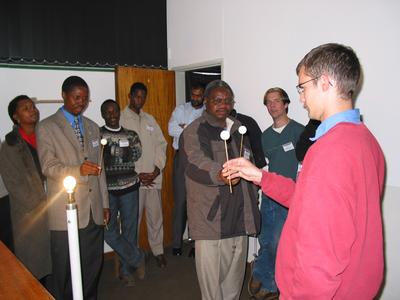 Trying out for ourselves how to demonstrate the phases of the Moon
using a lamp and table tennis ball.
Trying out for ourselves how to demonstrate the phases of the Moon
using a lamp and table tennis ball.
Stuck with no resources, we would use
our fist as the Moon and the Sun as itself, while our head stands in for the
Earth.
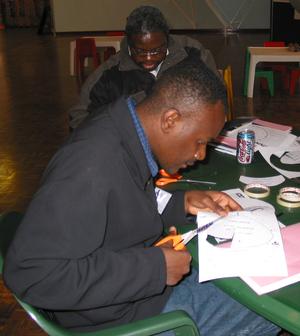 Cutting out the card parts for the starfinders (planispheres).
Cutting out the card parts for the starfinders (planispheres).
The commercial plastic versions of these cost about R140.
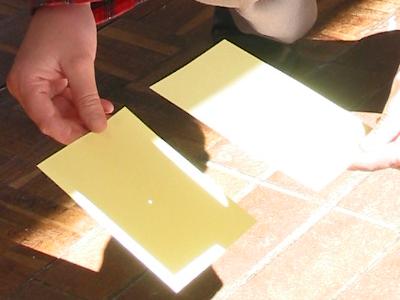 Trying out a pinhole in a card to project an image of the Sun.
Trying out a pinhole in a card to project an image of the Sun.
This is the cheapest
and safest way of viewing an eclipse.
Here the Sun's image looks round - no
eclipse happening right now!
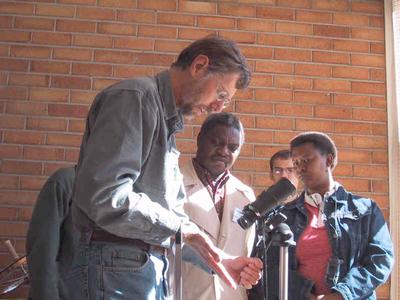 How do we aim binoculars at the Sun when we must not look through
them?
How do we aim binoculars at the Sun when we must not look through
them?
Mike Gaylard shows how.
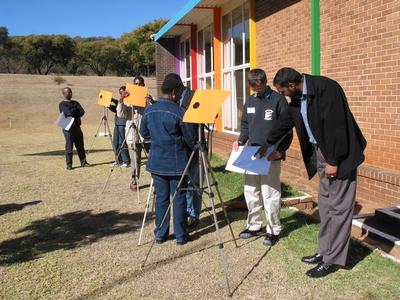 Logan assists in setting up the binoculars on tripods to project images of
the Sun.
Logan assists in setting up the binoculars on tripods to project images of
the Sun.
Three sunspot groups showed clearly with these 7x50 and 10x50
binoculars.
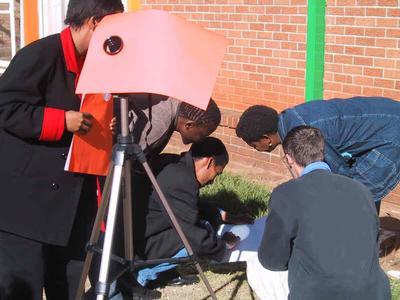 Just how many sunspots can we see?
Just how many sunspots can we see?
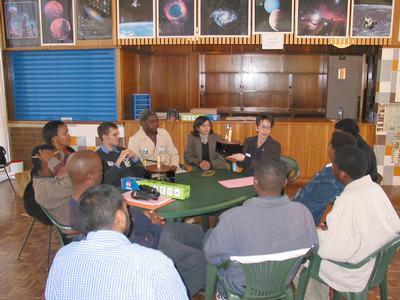 Kim shows how to use the HartRAO-designed orrery to show night and
day, the seasons, phases of the Moon, and eclipses.
Kim shows how to use the HartRAO-designed orrery to show night and
day, the seasons, phases of the Moon, and eclipses.
Note the black
sectioned binoculars lying on the table.
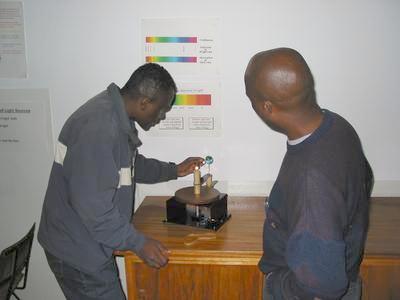 Trying out the new orreries in the dark room in the Visitors Centre.
Trying out the new orreries in the dark room in the Visitors Centre.
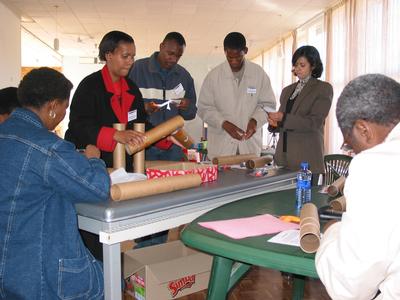 Colleen from FEST, in the grey
suit, has joined us in making Galilean telescopes.
Colleen from FEST, in the grey
suit, has joined us in making Galilean telescopes.
They give an upright
image, unlike astronomical refractor telescopes.
These are the excellent
kits developed by Case Rijsdijk at SAAO.
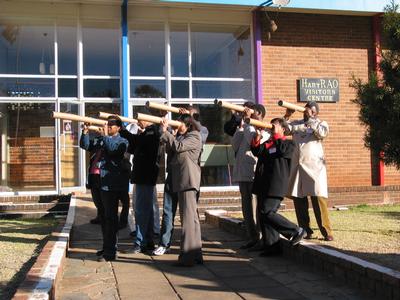 Yes! The telescopes work!
Yes! The telescopes work!
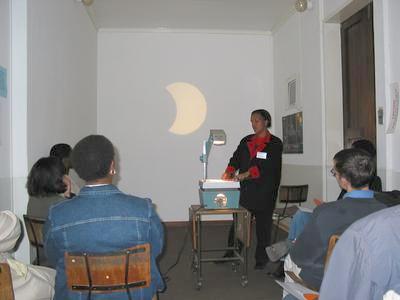 Pulane shows the very effective eclipse simulations that can be done using
card cutouts on an overhead projector.
Pulane shows the very effective eclipse simulations that can be done using
card cutouts on an overhead projector.
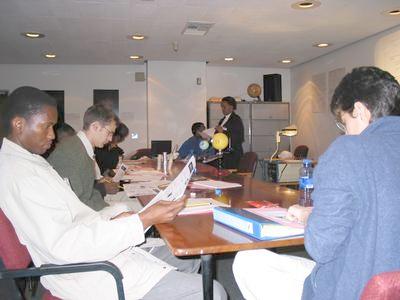 Planning strategy: where to from here?
Planning strategy: where to from here?
The A4 leaflets devised at HartRAO
and the orrery provide inspiration.
Flip charts stuck to the wall reflect
the perspiration.
www.hartrao.ac.za/news/020708eclwkshp/eclwkphotos.html
created 2002/07/16 by Science Awareness team, e-mail: visit@hartrao.ac.za



























